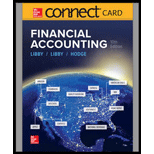
1.
Complete the T-account worksheet that is used to prepare the statement of
1.
Explanation of Solution
T-account:
T-account is the form of the ledger account, where the
Following are the changes in cash accounts:
| Cash (A) | |||
|
Operating activities: | |||
| (1) Net income | 20,200 | (3) Inventory | 7,000 |
| (2) | 3,000 | (4) Accounts payable | 3,000 |
| (3) Income taxes payable | 1,500 | (5) Wages payable | 1,500 |
| Net cash flow provided by operating activities | 13,700 | ||
| Investing activities: | |||
| (7) Sale of equipment | 6,000 | (8) Purchased investments | 15,000 |
| Net cash flow provided by investing activities | 9,000 | ||
| Financing activities: | |||
| (9) Proceeds from stock issuance | 6,000 | (10) Payment of dividends | 12,000 |
| Net cash flow used by financing activities | 6,000 | ||
| Net decrease in cash and cash equivalents | 1,300 | ||
Following are the changes in non-cash accounts:
| Beginning balance 22,000 | |||||
| Ending balance 22,000 | |||||
| Merchandise Inventory (A) | |||||
| Beginning balance 68,000 | |||||
| (3) Increase 7,000 | |||||
| Ending balance 75,000 | |||||
| Accounts payable (L) | ||
| Beginning balance | ||
| (4) Decrease 7,000 | 17,000 | |
| Ending balance | 14,000 | |
| Wages payable (L) | ||
| Beginning balance | 2,500 | |
| (5) Decrease 1,000 | ||
| Ending balance | 1,500 | |
| Income taxes payable (L) | ||
| Beginning balance | 3,000 | |
| (6) Increase | 1,500 | |
| Ending balance | 4,500 | |
| Equipment (A) | ||
| Beginning balance 114,500 | ||
| Purchases 0 | (7)Disposals | 21,000 |
| Ending balance 93,500 | ||
| Beginning balance | 32,000 | |
| (7) Disposals | (2)Depreciation | 3,000 |
| Ending balance | 20,000 | |
| Investments (A) | ||
| Beginning balance 0 | ||
| (8) Purchases 15,000 | Disposals | 0 |
| Ending balance 15,000 | ||
| Contributed Capital (SE) | ||
| Beginning balance | 100,000 | |
| Stock repurchased | (9)Stock issued | 6,000 |
| Ending balance | 106,000 | |
| Beginning balance | 100,000 | |
| Stock repurchased | (9) Stock issued | 6,000 |
| Ending balance | 106,000 | |
Note: L represents liabilities, XA represents contra-asset, A represents asset and SE represents
2.
Prepare the statement of cash flows for the current year.
2.
Explanation of Solution
Statement of cash flows:
This statement reports all the cash transactions which are responsible for inflow and outflow of cash, and result of these transactions is reported as ending balance of cash at the end of reported period.
Indirect method:
Indirect method uses the accrual basis of accounting, where the Net Income is adjusted to determine the net cash provided from operating activities.
Prepare the statement of cash flows for the current year of Company G.
| Company G | ||
| Statement of Cash Flows (Indirect Method) | ||
| For the year ended December 31 | ||
| Particulars | Amount ($) | Amount ($) |
| Cash flows from operating activities: | ||
| Net income | 20,200 | |
| Add: Depreciation expenses | 3,000 | |
| Changes in current assets and current liabilities | ||
| Less: Increase in inventory | (7,000) | |
| Less: Decrease in accounts payable | (3,000) | |
| Less: Decrease in wages payable | (1,000) | |
| Add: Increase in income taxes payable | 1,500 | |
| Net cash flows from operating activities | 13,700 | |
| Cash flows from Investing activities: | ||
| Less: Purchase of fixed assets | (15,000) | |
| Add: Proceeds from sale of equipment | 6,000 | |
| Net cash flows from investing activities | (9,000) | |
| Cash flows from Financing activities: | ||
| Add: Sale of capital stock | 6,000 | |
| Less: Dividends paid | (12,000) | |
| Net cash flows from financing activities | (6,000) | |
| Net increase (decrease) in cash | (1,300) | |
| Cash balance at the beginning | 20,500 | |
| Cash balance at the end | 19,200 | |
Table (1)
Want to see more full solutions like this?
Chapter 12 Solutions
Connect Access Card For Financial Accounting
- kindly help me with thisGeneral accounting question not use chart gptarrow_forwardManufacturing Cost added during the period arearrow_forwardBobby Corp. had the following transactions during 2019: -Sales of $8820 on account. -Collected $3920 for services to be performed in 2020. -Paid $3680 cash in salaries for 2019. -Purchased airline tickets for $490 in December for a trip to take place in 2020. What is Bobby's 2019 net income using accrual accounting?arrow_forward

 AccountingAccountingISBN:9781337272094Author:WARREN, Carl S., Reeve, James M., Duchac, Jonathan E.Publisher:Cengage Learning,
AccountingAccountingISBN:9781337272094Author:WARREN, Carl S., Reeve, James M., Duchac, Jonathan E.Publisher:Cengage Learning, Accounting Information SystemsAccountingISBN:9781337619202Author:Hall, James A.Publisher:Cengage Learning,
Accounting Information SystemsAccountingISBN:9781337619202Author:Hall, James A.Publisher:Cengage Learning, Horngren's Cost Accounting: A Managerial Emphasis...AccountingISBN:9780134475585Author:Srikant M. Datar, Madhav V. RajanPublisher:PEARSON
Horngren's Cost Accounting: A Managerial Emphasis...AccountingISBN:9780134475585Author:Srikant M. Datar, Madhav V. RajanPublisher:PEARSON Intermediate AccountingAccountingISBN:9781259722660Author:J. David Spiceland, Mark W. Nelson, Wayne M ThomasPublisher:McGraw-Hill Education
Intermediate AccountingAccountingISBN:9781259722660Author:J. David Spiceland, Mark W. Nelson, Wayne M ThomasPublisher:McGraw-Hill Education Financial and Managerial AccountingAccountingISBN:9781259726705Author:John J Wild, Ken W. Shaw, Barbara Chiappetta Fundamental Accounting PrinciplesPublisher:McGraw-Hill Education
Financial and Managerial AccountingAccountingISBN:9781259726705Author:John J Wild, Ken W. Shaw, Barbara Chiappetta Fundamental Accounting PrinciplesPublisher:McGraw-Hill Education





